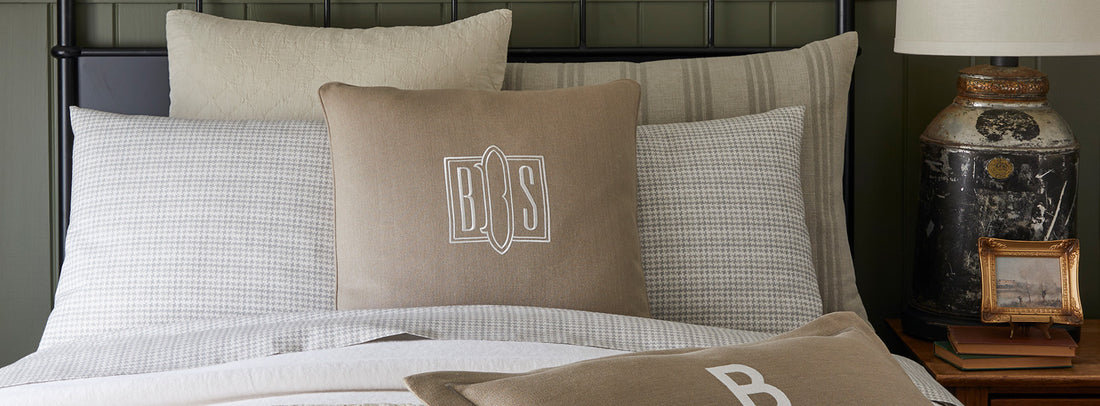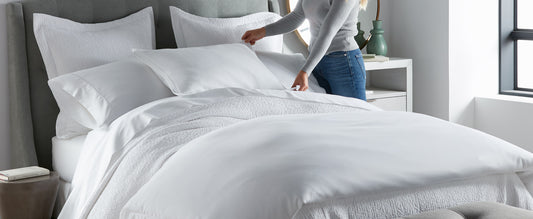Before you can build a luxurious bedding set, you need to know about the different bedding parts. To help you, we’ve put together a handy guide about the basic parts of bedding and each piece's role. We’ll guide you through selecting the right pieces for your preferences and style and discuss how to maintain and care for them. Let’s begin.
The Essential Parts of a Bed Set
Mattress Protectors and Toppers
Mattress protectors shield your mattress from dirt, sweat, and allergens. They come in a wide range of materials, including cotton, down, wool, polyester, and vinyl. Some also have waterproofing, cooling elements, and hypoallergenic properties. Which type you choose will depend on your sleeping preferences and household needs. If you want to add extra cushion to your mattress, consider choosing a mattress topper instead.

Down Alternative Mattress Topper
Pillows
A standard bedding setup has a mix of bed pillows and throw pillows. Bed pillows are your main sleeping pillows and play an essential part in how well you sleep at night, so you’ll want to choose pillows that fit your sleeping style and position (i.e., back, side, or stomach).
For example, a quality down pillow, like Peacock Alley’s white goose-down pillow, often appeals to many styles. (Plus, it’s responsibly sourced and incredibly soft.)
If you prefer firmer support, opt for duck feathers mixed with down. And for an allergen-free alternative, go with a down-alternative pillow made of luxe fibers that offer the same loftiness of down.

White Goose Down Pillow

Down Alternative Pillows

Silk Pillow Enhancer
Sheets
There are three main types of sheets: fitted, flat, and pillowcases.
A fitted sheet hugs your mattress tightly, keeps everything in place, and adds extra protection and softness. While some consider flat sheets an optional layer, they add a layer of warmth and help keep your duvet or coverlet clean. And finally, pillowcases protect your skin and keep your pillow fresh.
The type of material you choose for your sheets will depend on factors like allergies, sleeping temperature, and texture preferences.
Blankets, Duvets & Comforters
Blankets are single-layered and come in various levels of thickness, which can be ideal if you’re looking for a lighter layer. Comforters and duvets, on the other hand, offer more insulation and are great for sleepers who need extra warmth. They have two layers of fabric (like cotton, wool, down, or silk) with a filling between those layers.


All Seasons Cotton Blanket

Riviera Waffle Weave Blanket
But how exactly do comforters and duvets differ from each other? The main characteristic that sets them apart is that a comforter is one part, and a duvet is two: an insert and a cover. Duvet inserts and comforters made of down are known for being extremely soft, breathable, and durable. But if you suffer from allergies or need a more budget-friendly option, a quality down alternative is also a great choice.
Whether filled with the finest European goose down or our Dacron® down alternative, Peacock Alley’s duvet inserts can help you get a good night’s sleep.

White Goose Down Duvet

Down Alternative Duvet

Down Alternative Bundle
Coverlets, Bedspreads, and Quilts
Coverlets, or bedspreads, are an added layer of bedding for decoration and warmth. They’re also a good top cover in warmer climates. Meanwhile, quilts are heavier and ideal for colder nights since they have three layers: a top sheet, inner batting, and a bottom sheet.


Hamilton Quilted Coverlet
Example product title
Bed Skirts
Bed skirts use stylish fabric to conceal your bed’s box spring or foundation. Since they hang down, they’re also great for hiding the space underneath your bed. If you want something that only stretches over the foundation, consider a box spring cover.
How to Select the Appropriate Design and Style for Your Bedroom
Now that you know the basic breakdown of bedding parts, it’s time to make the style of your bedroom all your own. That’s where decorative pieces and accessories come into play. Finishing touches like pillow shams, throw pillows, and throw blankets can make your bed look stylish and feel luxurious. Added comforts like a wedge or body pillow can also elevate your sleeping experience.

Optional Add-ons and Accessories
Caring for Your Bedding Components
Cleaning and Maintenance Tips
Switch out your sheets and pillow covers every one to two weeks — sooner if they need refreshing. Duvet inserts and pillows, however, can be washed less frequently, like every three or so months, or whenever there’s an accident or a stain.
When it comes to decorative pillows and throws, carefully follow the care instructions and spot clean when needed.
To prolong the life of your linens, consider line-drying your luxurious bedding sets. This also saves energy and makes the material smell fresh and clean.

Proper Storage for Bedding
To protect against mildew and sour odors, wait until your bedding is completely dry before folding and putting it away. (You’ll also want to avoid damp storage areas.)
Keep your items in a cool, dry place with plenty of air circulation.
When to Replace Bedding
To maintain good bedroom hygiene, replace your bedding essentials regularly. A good rule of thumb? Swap out your pillows every year and your bedding every 18 to 24 months.
Final Thoughts on Bedding and Bedding Parts
Understanding the basic parts of bedding is the first step in creating the bedroom of your dreams. Now that you know the essentials, you can evaluate your current bedding and make necessary adjustments. And Peacock Alley is here to help each step of the way.
With over 40 years of experience creating luxurious bedding, we’ve curated an opulent collection that’s both modern and classic. From decorative dust ruffles to the finest European goose-down duvets, Peacock Alley offers high-end bedding to enhance your design style and complement the bedroom of your dreams.






















